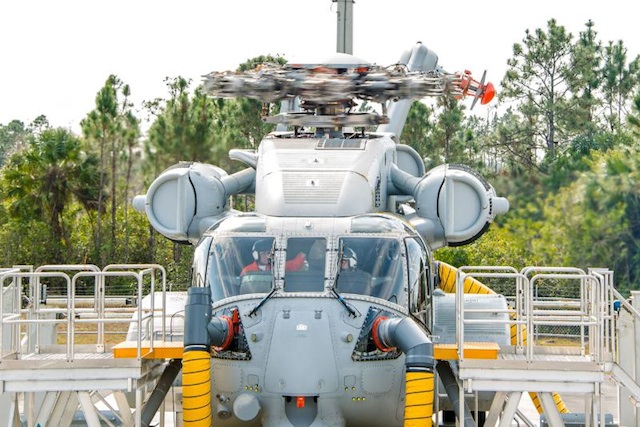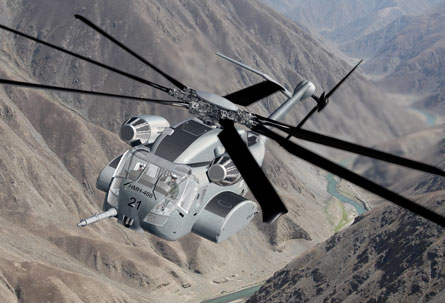The giant grey frame of a prototype Sikorsky CH-53K heavy lift helicopter rests on a concrete stand under South Florida’s hot winter sun, ready for testing.
But the prototype is not an aircraft – it is a ground test vehicle, mounted on a pedestal bolted to the aircraft’s transmission.
On a recent day, engineers prepared to fire up the GTV’s General Electric GE38-1B engines as part of a testing programme that Sikorsky says will lead to a first flight of the 39.9t gross weight helicopter by the end of the year.
The company tells Flightglobal that despite some minor problems, the programme remains on track for the aircraft to reach initial operational capability with the US Marine Corps by 2019.
“There are no significant technical issues,” Michael Torok, Sikorsky’s vice president of the programme, says during a tour of the facility. “There are no show stoppers.”

Sikorsky turns the rotor head on the GTV during "bare-head light-off" tests of the three main GE38-1B engines in December. Sikorsky.
That is not to say there have been no problems.
Although an acquisition report in late 2012 said the programme is “technically sound” and will likely reach all performance parameters, a 2013 report from the Department of Defense's inspector general noted that it has suffered “contractor manufacturing delays and failures during component testing”.
Torok concedes there have been setbacks that he describes as minor, but insists Sikorsky has faced no “technically challenging problems.” For instance, the company has needed to make electrical boxes and other electrical equipment such as resistors "more robust" to better withstand vibration. In addition, Sikorsky also needed to address unexpected compression of a bearing spacer located on the tail rotor shaft.
But he adds: “There is nothing on the list that we don’t have a fix [for] in the works.”

Rendering of CH-53K showing "anhedral" rotor tips.
The company has already been testing the CH-53K’s seven main all-composite rotor blades and its four tail rotor blades at its headquarters in Stratford, Connecticut.
In December, the company first powered up the GTV’s auxiliary power unit in Florida, starting the so-called “bare-head light-off” tests of the engines and the rotor without blades. The GTV’s three main engines were started in January, and turned the rotor head.
Sikorsky says it hopes to begin testing the engines with the blades attached – the “shakedown light-off” tests – in the next three to four weeks.
Before first flight, about 200h of GTV testing must be completed, including 150h of “shakedown” tests during which the company will ensure that multiple systems are integrating and operating as designed.
The final 50h will be for a pre-flight acceptance test activity, which will include “multiple cycles of full aircraft operational demonstration” – a requirement for flight clearance, Sikorsky says.
GTV tests will then continue simultaneously with flight tests, which will be conducted on four flight test aircraft being produced in West Palm Beach.
Despite similarities to Sikorsky’s CH-53E Super Stallion, the CH-53K is an “all new aircraft” with a “clean-sheet design”, Torok says. Its three turbines can crank out 7,500shp each, compared with the 4,380shp GE T64 powerplants on the legacy platform. That power drives main rotor blades with downward sweeping anhedral tips designed to minimize drag-inducing vortexes.
The main rotors are 10.7m (35ft) long and nearly 0.9m wide, with 12% more surface area than the E-model. The 3m-long tail rotors have 15% more surface area, Sikorsky says.
Those changes, plus a newly designed gearbox, will allow the CH-53K to carry an external load of more than 12,200kg (26,900lb) over a mission radius of 110nm (204km): triple the capacity of the E-model, according to the company. In addition, the aircraft will have a digital fly-by-wire system and a larger cargo hold that will be able to carry standard US Air Force 463L pallets, Sikorsky says.
The programme launched in 2006 when Sikorsky won a $3.5 billion system development and demonstration contract that called for the production of the GTV, four flight test aircraft, one “static test article” and one “fatigue test article”.
The company announced in mid-2013 that the US Navy had added $435 million to the contract to build four system demonstration test articles (SDTAs), which the US Marine Corps will use to conduct operational evaluation tests. The DoD's programme of record now calls for Sikorsky to eventually deliver 200 aircraft to the service, including the four STDAs.
Production is scheduled to ramp up beginning in fiscal year 2018, with full-rate production to be reached by fiscal year 2023.Sikorsky says it has not determined if CH-53K production will ultimately be in Stratford or Florida.
Major contractors include Spirit AeroSystems, which is building the cockpit and cabin, GKN Aerospace, maker of the aft fuselage section, Exelis, which is building parts of the tail assembly, and ITT, producer of CH-53K’s dual sponsons, which will hold 4,730 litres (1,250USgal) of fuel each.
Source: FlightGlobal.com
















